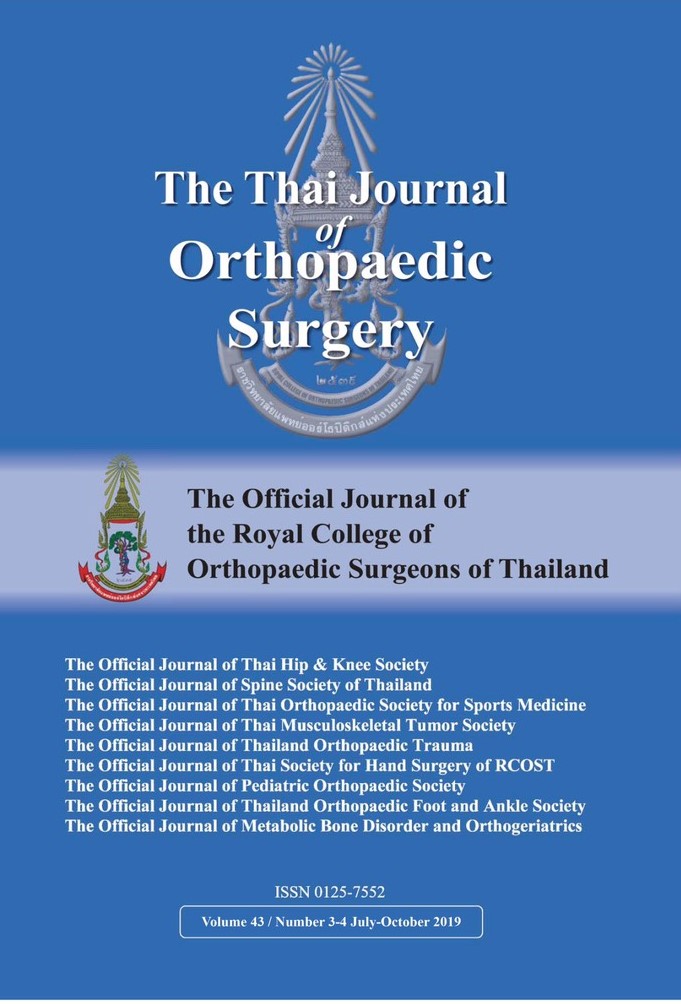Comparison of Remnant-Preserving Augmentation and Double-Bundle Reconstruction for Partial Anterior Cruciate Ligament Tears
Main Article Content
Abstract
Purpose: The most effective method for the surgical treatment of partial anterior cruciate ligament tears has not been definitively established. Two commonly used techniques are remnant-preserving augmentation and double-bundle reconstruction. This retrospective study was conducted to test the hypothesis that clinical outcomes are similar with the two methods.
Methods: A total of 43 patients who had been treated for partial anterior cruciate ligament tears by either remnant-preserving augmentation or double-bundle reconstruction were included. Twenty-one patients were treated with remnant-preserving augmentation and 22 were treated with double-bundle reconstruction. Patient data collected included preoperative and postoperative range of motion, visual analog scale, Lysholm Knee Scoring, International Knee Documentation Committee Knee Evaluation Form scores, anterior drawer test, Lachman test and pivot-shift test.
Results: There were no significant differences in postoperative range of motion, visual analog scale score, Lysholm score or International Knee Documentation Committee knee evaluation form score between the two groups (P > .05). The pivot-shift test was significantly better in the remnant-preserving augmentation group than the double-bundle reconstruction group (P = .040); however, there was no significant difference between the two groups in either the anterior drawer test or the Lachman test (P > .05).
Conclusions: The effectiveness of remnant-preserving augmentation is comparable to double-bundle reconstruction in the treatment of partial anterior cruciate ligament tears in terms of anterior and rotary stability and clinical scores.
Article Details
References
2. Perelli S, Ibañez F, Gelber PE, Erquicia JI, Pelfort X, Monllau JC. Selective bundle reconstruction in partial ACL tears leads to excellent long-term functional outcomes and a low percentage of failures. Knee. 2019; 26(6): 1262-70.
3. Shohat N, Lindner D, Tamir E, Beer Y, Agar G. Prospective comparison between remnant-preserving augmentation and double-bundle reconstruction in anterior cruciate ligament Tears. Isr Med Assoc J. 2017; 19(6): 355-9.
4. Yoo YS, Song SY, Yang CJ, Ha JM, Kim YS, Seo YJ. A comparison between clinical results of selective bundle and double bundle anterior cruciate ligament reconstruction. Yonsei Med J. 2016; 57(5): 1199-208.
5. Choi S, Kim MK, Kwon YS, Kang H. Clinical and arthroscopic outcome of single bundle anterior cruciate ligament reconstruction: comparison of remnant preservation versus conventional technique. Knee. 2017; 24(5): 1025-32.
6. Sonnery-Cottet B, Lavoie F, Ogassawara R, Scussiato RG, Kidder JF, Chambat P. Selective anteromedial bundle reconstruction in partial ACL tear: a series of 36 patients with mean 24 months follow-up. Knee Surg Sports Traumatol Arthrosc. 2010; 18(1): 47-51.
7. Yoon KH, Bae DK, Cho SM, Park SY, Lee JH. Standard anterior cruciate ligament reconstruction versus isolated single-bundle augmentation with hamstring autograft. Arthroscopy. 2009; 25(11): 1265-74.
8. Ahn JH, Lee YS, Ha HC. Anterior cruciate ligament reconstruction with preservation of remnant bundle using hamstring autograft: technical note. Arch Orthop Trauma Surg. 2009; 129(8): 1011-5.
9. Lee BI, Kwon SW, Kim JB, Choi HS, Min KD. Comparison of clinical results according to amount of preserved remnant in arthroscopic anterior cruciate ligament reconstruction using quadrupled hamstring graft. Arthroscopy. 2008; 24(5): 560-8.
10. Ochi M, Adachi N, Uchio Y, Deie M, Kumahashi N, Ishikawa M, et al. A minimum 2-year follow-up after selective anteromedial or posterolateral bundle anterior cruciate ligament reconstruction. Arthroscopy. 2009; 25(2): 117-22.
11. Siebold R, Fu FH. Assessment and augmentation of symptomatic anteromedial or posterolateral bundle tears of the anterior cruciate ligament. Arthroscopy. 2008; 24(11): 1289-98.
12. Adachi N, Ochi M, Uchio Y, Sumen Y. Anterior cruciate ligament augmentation under arthroscopy. Arch Orthop Trauma Surg. 2000; 120(3-4): 128-33.
13. Ahn JH, Wang JH, Lee YS, Kim IG, Kang JH, Koh KH. Anterior cruciate ligament reconstruction using remnant preservation and a femoral tensioning technique: clinical and magnetic resonance imaging result. Arthroscopy. 2011; 21(8): 1079-89.
14. Levy IM, Torzilli PA, Warren RF. The effect of medial meniscectomy on anteroposterior knee motion. J Bone Joint Surg Am. 1982; 64(6): 883-8.
15. Cho HJ, Lee JH, Bae DK, Song SJ, Yoon KH. The effect of meniscectomy on clinical result after ACL reconstruction. J Korean Arthrosc Soc. 2010; 14: 7-12.
16. Gabriel MT, Wong EK, Woo SL, Yagi M, Debski RE. Distribution of in situ forces in the anterior cruciate ligament in response to rotatory loads. J Orthop Res. 2004; 22(1): 85-9.
17. Yagi M, Wong EK, Kanamori A, Debski RE, Fu FH, Woo SL. Biomechanical analysis of an anatomic anterior cruciate ligament reconstruction. Am J Sports Med. 2002; 30(5): 660-6.
18. Zantop T, Brucker PU, Vidal A, Zelle BA, Fu FH. Intraarticular rupture pattern of the ACL. Clin Orthop Relat Res. 2007; 454: 48-53.
19. Ryu RK, Dunbar WH 4th. Arthroscopic meniscal repair with two year follow-up: A clinical review. Arthroscopy. 1998; 4(3): 168-73.
20. Barber FA, Click SD. Meniscus repair rehabilitation with concurrent anterior cruciate reconstruction. Arthroscopy. 1997; 13(4): 433-7.
21. Irrgang JJ, Pezzullo D. Rehabilitation following surgical procedures to address articular cartilage lesions in the knee. J Orthop Sports Phys Ther. 1998; 28(4): 232-40.


